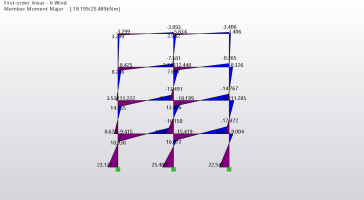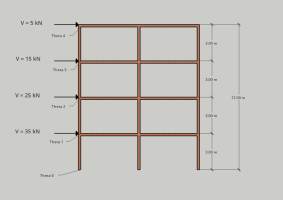Thing is the rotation for the single cantilever beam will not work for a muiltistorey frame. However, using some approximate methods for deflection I have managed to come up with a value for [imath]\theta B[/imath]. Try using a value of 0.00010289 rads.
Does this answer make sense to you? I will trust you that it is correct and will give you a taste of the idea. The idea of numerical analysis is to divide the interval (length of the beam) [imath]0 < x < L[/imath] by some number [imath]n[/imath] into subintervals. In other words, you will have many interior points around the boundary points.
If [imath]\theta_0 = 0[/imath] and [imath]\theta_L = 0.00010289[/imath] are the boundary conditions, then [imath]\theta_1, \theta_2, \theta_3,\cdot\cdot\cdot, \theta_{i-1}[/imath] are the interior functions that we want to find. And [imath]x_1,x_2,x_3,\cdot\cdot\cdot,x_{i-1}[/imath] are the interior points for [imath]\theta_1, \theta_2, \theta_3,\cdot\cdot\cdot, \theta_{i-1}[/imath] respectively.
The larger the number [imath]n[/imath], the better the approximation gets. But increasing the number [imath]n[/imath] will in return cost us to solve more equations.
Let us choose [imath]n = 10[/imath], then the length [imath]h[/imath] of [imath]1[/imath] subinterval is equal to [imath]h = \displaystyle \frac{x_{10} - x_0}{n} = \frac{L - 0}{10}[/imath]. It depends on the length of the beam, say, [imath]L = 8 \ \text{m}[/imath], then [imath]\displaystyle h = \frac{8 - 0}{10} = 0.8[/imath]
The interior points are:
[imath]x_1 = 0.8[/imath]
[imath]x_2 = 1.6[/imath]
[imath]x_3 = 2.4[/imath]
[imath]x_4 = 3.2[/imath]
[imath]x_5 = 4.0[/imath]
[imath]x_6 = 4.8[/imath]
[imath]x_7 = 5.6[/imath]
[imath]x_8 = 6.4[/imath]
[imath]x_9 = 7.2[/imath]
While [imath]x_0 = 0[/imath] and [imath]x_{10} = 8[/imath] are the boundary points.
Now go back to the difference equation and focus on the variables that have the index [imath]i[/imath], one of them is [imath]x_i[/imath]. We need to know it to continue our analysis.



